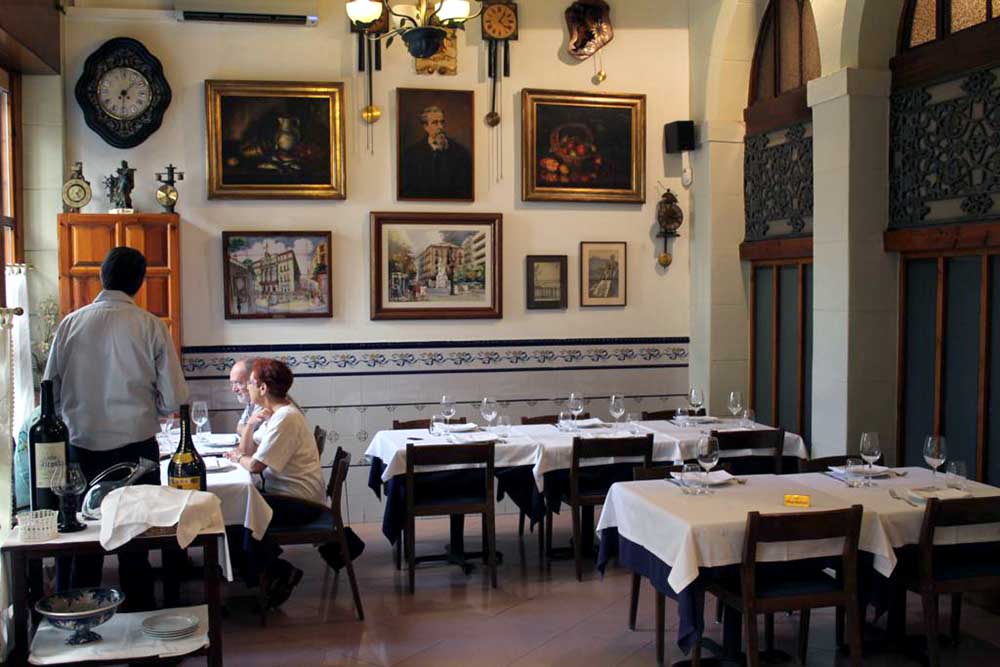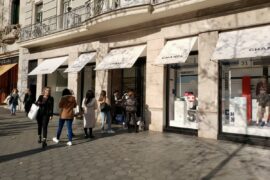[dropcap letter=”I”]
n the last 127 years, Carrer Avinyó (Avinyó Street) would be Pitarra’s street, one of the classic restaurants of the Barcelona’s Gothic district, a place with a long history tightly linked to Barcelona’s neighbourhood and culture. The restaurant is named after Frederic Soler Pitarra, its former proprietor –or rather, heir–, and its reputation comes from the meetings organized by this prestigious playwright in the backroom of his store, a watchmaker’s back then, which gathered leading intellectuals from mid-19th century’s Barcelona. Throughout the 20th century, Pitarra became a milestone of Avinyó Street –where else would a young Picasso have a drink before visiting his ladies?– and it was currently one of the last representatives of classic Catalan cuisine of the zero zone: in a time accustomed to chill out music to create an ambience, eating there was a trip back memory lane, with its walls cluttered with old pictures and the mandatory snow-white tablecloths, quickly and inevitably peppered with red wine stains as the conversation drew on.
Last April, Pitarra, the ‘cradle of Catalan theatre’, shut down permanently amidst the umpteenth “it’s impossible, are we all mad” campaign in the media and social media. Following the death of its historic owner, Jaume Roig, it seems that the new proprietor wanted to make more money and transformed it into Scruffy Murphy’s (can anybody explain to me why should Irish pubs have such grubby names?).
The new pub has not even lasted three months, as revealed by journalist Jordi Nopca on Twitter, the exact time to cater for the alcoholic needs of tourists during the Football World Cup, and supply the booze for a few thousand Englishmen. Everyone knows that one of the main needs in the Gothic quarter is a beer haven for the English. The business has certainly worked out for all of us: the Barcelona citizens, the tourists, the Gothic quarter and its owner, who is, by now, searching for someone who could set up the umpteenth eatery franchise.
It is about time we realized these historical stores are the contemporary downtown version of Antoni Gaudí and Josep Puig i Cadafalch, the essential icons that define the idiosyncrasy of a street and mark the differences between them
This is the monthly standard procedure of the last few years of bookshops, chocolate stores, drugstores and other historical stores that are forced to close down on account of income pressure and open up revamped as yet another umpteenth soul-less store that does not last long. As years go by, the Barcelona City Council seems to have no actual plan to protect these stores –and there are fewer and fewer every day, tick-tock-tick-tock– nor any idea how to guarantee their continuity. Because, let’s face it, this is not a question of a free market; this is about preserving public interest –and this is what makes Barcelona what it is, the signs of identity of every district, of every neighbourhood– over speculative short-term-ness. Shall we then buy out Pitarra and open up a public call for tenders, and get someone to take care of it? By all means, let’s do it, we will surely find a young cook eager enough to grill pork’s feet all their life.

During the 20th century, we learnt to preserve Modernism, our Art Nouveau, and that we could not continue losing architectural jewels every time the “King of bricks” builds a block of flats. It is precisely this preserved Modernist art what has put Barcelona on the map and lured millions of visitors to the city. It is about time we realized these historical stores are the contemporary downtown version of Antoni Gaudí and Josep Puig i Cadafalch, the essential icons that define the idiosyncrasy of a street and mark the differences between them.
George Steiner used to say that the idea of Europe pivoted around its cafés: unique and unmatched spaces for conversation and rendezvous. What is the future that awaits Europe if we substitute cafés with burger stores and green juice shops?





















